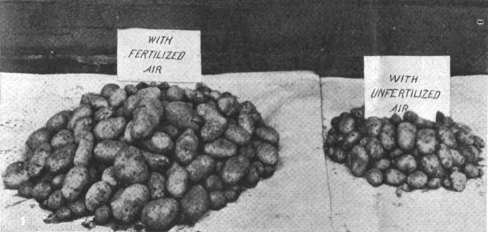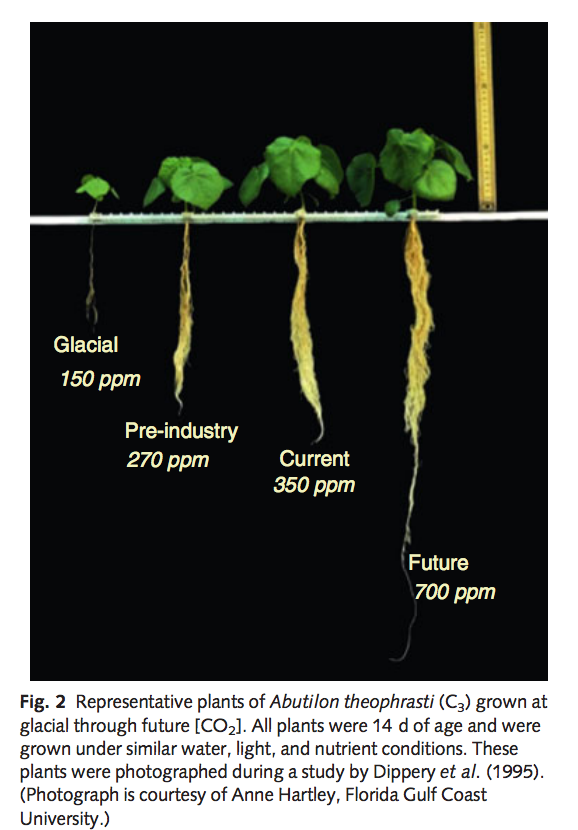It looks like you're using an Ad Blocker.
Please white-list or disable AboveTopSecret.com in your ad-blocking tool.
Thank you.
Some features of ATS will be disabled while you continue to use an ad-blocker.
share:
originally posted by: D8Tee
a reply to: Greven
‘Number of pairs’ refers to the number of comparisons in which replicates of a particular cultivar grown at a specific site under one set of growing conditions in one year at elevated [CO2] have been pooled and
mean nutrient values for these replicates were compared with mean values for identical cultivars under identical growing conditions except grown at ambient [CO2]
The paper shows what is to be expected if they do not increase the Nitrogen fertilizer for the increased C02 rates.
Every year on the farm we would take soil samples and sent them in and fertilize accordingly.
You can't expect to change the C02 variable and not change the fertilizer applied to the crop can you?
I'm not an agrologist, but I suspect the crops were nitrogen limited, and the data indicates that.
The nitrogen fixing legumes and sorghum were not as low in protein as the non nitrogen fixing crops grown.
Isn't that what you've been arguing, though? That - ceteris paribus - CO2 increase would have a fertilization effect?
The increased CO2 levels were, by the way, 550 ppm - the expected atmospheric concentration by 2050.
a reply to: Greven
There's more to the fertilization than just the C02 needed or respiration.
There's the whole N-P-K thing that goes along with it, plus the micronutrients.
Get the fertilization wrong, yields and protein will be down.
Yes, I'm aware of what the levels were, I do in fact read most of the papers that people present to me and try to understand where they are coming from.
I do try to advance my own knowledge via these forums and not just paint myself into a corner of indefensible positioning.
There's more to the fertilization than just the C02 needed or respiration.
There's the whole N-P-K thing that goes along with it, plus the micronutrients.
Get the fertilization wrong, yields and protein will be down.
Yes, I'm aware of what the levels were, I do in fact read most of the papers that people present to me and try to understand where they are coming from.
I do try to advance my own knowledge via these forums and not just paint myself into a corner of indefensible positioning.
edit on 6-5-2017 by D8Tee because: (no reason given)
edit on 6-5-2017 by D8Tee because: (no reason given)
a reply to: Greven
Scientific American
Large scale tests were carried out many years ago with excellent results.
That - ceteris paribus - CO2 increase would have a fertilization effect?
Scientific American
originally posted by: charlyv
It would be interesting if a "fossil fuel" phase is common in most alien civilizations, assuming they are biological.
A kick starter, if you will, to advancing to a stage where it can be replaced before it runs out. Would a coal layer have to be unique to Earth, or a planet much like Earth?
Coal and oil come from trees that fell down and also decomposed or liquified but weren't recycled by anything else like termites, ants, fungi or other plants. This may have been due to tsunami, forest fire, sudden flooding, earthquake and ground liquifaction. Then they got buried under other layers of clay and sand, where the water was eventually squeezed out, leaving behind domes of oil and gas under pressure.
It would depend on the chemical makeup of those planets, but if water is necessary to be in a liquid phase, then some hydrocarbons would be present as liquids and others as gases. Photosynthesis requires infra-red and ultra-violet wavelengths of light. Carbon seems to be the backbone of DNA and amino acids form readily in liquid environments with lightning. Then basic growth patterns like branching would create lifeforms like trees and plants.
originally posted by: Greven
a reply to: D8Tee
Looks like it's also here if you want to read it.
An increase to CO2 only helps if it's the limiting factor. Greenhouses generally need CO2 pumped in because the plants within consume the CO2 in the semi-enclosed environment. This happens outdoors as well - corn fields, for example, will have reduced CO2 levels at ground level.
How come no where in that paper do they talk about yields of the crops?
It would be interesting to see how the yields were affected with C02 supplementation.
They seem to have left that dog lay, unless I am missing something?
originally posted by: Greven
a reply to: D8Tee
The objective of the paper was to determine nutrient content changes.
You could ask them, I don't know the answer.
Yield increase has been studied anyways.
It's very real.
Just didn't fit the papers agenda to mention it.


Link to Scientific American
new topics
-
Let's talk planes.
General Chit Chat: 7 hours ago -
January 6th report shows disturbing trend (nobody is shocked)
US Political Madness: 8 hours ago -
Inexplicable military simulation - virtual reality showdown in the night..
The Gray Area: 9 hours ago -
The Truth about Migrant Crime in Britain.
Social Issues and Civil Unrest: 10 hours ago
top topics
-
Trudeau Resigns! Breaking
Mainstream News: 12 hours ago, 26 flags -
January 6th report shows disturbing trend (nobody is shocked)
US Political Madness: 8 hours ago, 20 flags -
Live updates: Congress meets to certify Trump's presidential election victory
US Political Madness: 13 hours ago, 12 flags -
The Truth about Migrant Crime in Britain.
Social Issues and Civil Unrest: 10 hours ago, 10 flags -
Gravitic Propulsion--What IF the US and China Really Have it?
General Conspiracies: 13 hours ago, 9 flags -
Let's talk planes.
General Chit Chat: 7 hours ago, 5 flags -
Greatest thing you ever got, or bought?
General Chit Chat: 13 hours ago, 4 flags -
Inexplicable military simulation - virtual reality showdown in the night..
The Gray Area: 9 hours ago, 2 flags
active topics
-
January 6th report shows disturbing trend (nobody is shocked)
US Political Madness • 46 • : JadedGhost -
Judge rules president-elect Donald Trump must be sentenced in 'hush money' trial
US Political Madness • 31 • : JadedGhost -
Gravitic Propulsion--What IF the US and China Really Have it?
General Conspiracies • 16 • : YouSir -
Trudeau Resigns! Breaking
Mainstream News • 65 • : firerescue -
Greatest thing you ever got, or bought?
General Chit Chat • 21 • : rickymouse -
Islam And A Book Of Lies
Religion, Faith, And Theology • 12 • : nugget1 -
Trump says ownership of Greenland 'is an absolute necessity'
Other Current Events • 65 • : BingoMcGoof -
Let's talk planes.
General Chit Chat • 7 • : rickymouse -
Democrats Introduce Bill That Will Take Away Donald Trumps Secret Service Protection
2024 Elections • 77 • : WeMustCare -
OK this is sad but very strange stuff
Paranormal Studies • 8 • : rickymouse
